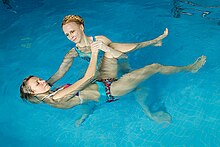Watsu
Watsu ( suitcase word from Wa ter and Japanese 指圧 Shia tsu , German , finger pressure ' ) or water Shiatsu is a hydro-therapeutic application. The therapist stands in chest-deep water and moves the client according to given figures, combining the positive properties of warm water with the basics of Shiatsu .
origin
In 1980 the Californian poet and Shiatsu master Harold Dull published a massage and relaxation therapy that he had devised in Harbin Hot Springs (California) . Dull headed a commercial therapy and training center for 20 years and has published several books on his method. In Switzerland , Watsu is a registered trademark and may only be used by authorized practitioners ( Swiss Federal Institute of Intellectual Property, trademark no. 570307).
method
Watsu is a massage and movement therapy based on the teachings of Zen - Shiatsu . The treatment takes place in 35 ° C warm water. The physical properties of the water are used. The body of the client, which is relieved of gravity by the static buoyancy , is passively stretched and stretched. The flow resistance in the water is used as a support. As in Shiatsu, these movements relate on the one hand to the meridians and on the other hand to the muscles and thus have a similar effect to any other passive movement therapy. It is important that the client never finds himself in a situation in which he has to react himself. He must be able to completely rely on the therapist and he must always have control over the client's body in the water.
effect
As with Shiatsu, the most important effect is deep relaxation (see also relaxation technique ). By trusting the therapist, his control and the warm water, a feeling of weightlessness can arise, which can be perceived both consciously and unconsciously.
In addition, there are the general modes of action of water, such as B. improved peripheral blood circulation, relief of joints. When working underwater, the therapist can specifically control the client's breathing. If used skilfully, effects similar to those of respiratory therapy are possible .
indication
Due to its deeply relaxing effect, Watsu is successfully used in psychosomatic rehabilitation . Watsu often finds its followers in the wellness sector , where the relaxing effect is also very much appreciated. In the scientific literature on rehabilitation or therapy with Watsu, there is still insufficient knowledge about the active principle of Watsu. In addition to a diploma thesis on the subject of "aquatic body work", there are so far only a few studies with a small number of cases in depression and fibromyalgia.
Contraindication
In general, the same contraindications apply to Watsu as to all forms of hydrotherapy. Because of the warm water, clients with cardiovascular diseases and a tendency to epileptic seizures should consult their doctor before starting therapy. Advanced arteriosclerotic diseases, acute febrile diseases and overt skin diseases are absolutely contraindicated . Clients with a chlorine intolerance cannot participate in treatments in chlorinated swimming pools.
Differentiation from related procedures
In addition to Watsu, there are other hot water therapies. But while with Watsu the client always stays on the surface of the water, with the water dance (or WaTa ) he also completely submerges. In this form of aquatic body work, the client's breathing rhythm is consciously recorded and integrated into the sequence of movements.
Other forms of application are Ocean Bodyworking / Aquawellness, Healing Dance and AquaRelax, some of which were created in parallel and are offered by various providers in structured training courses.
literature
- Harold Dull: Bodywork Tantra . Harbin Springs Publishing, 1978, ISBN 0-944202-00-4 .
- Harold Dull: Watsu: Freeing the Body in Water. 3. Edition. Trafford Publishing, 2004, ISBN 1-4120-3439-6 .
Web links
In German-speaking countries, Watsu is represented by the Aquamunda Institute and the Institute for Aquatic Body Work (IAKA). The IAKA exists in Germany, Austria and Switzerland. Both are members of the Worldwide Aquatic Bodywork Association (WABA).
Individual evidence
- ↑ Watsu study.pdf ( Memento from June 30, 2016 in the Internet Archive )
- ↑ Fibromyalgia Study.pdf ( Memento from August 16, 2016 in the Internet Archive )
- ↑ Frankfurter Rundschau : Let it drift once , from February 25, 2005, loaded on July 8, 2019
- ↑ SRF : Submerged and deeply relaxed , from September 5, 2011, loaded on July 8, 2019
- ↑ www.kobera.ch: Aquatic body work , loaded on July 8, 2019
- ↑ Wolf Schneider: Tao of water: Healing and relaxation - The warm water therapies. 2004, ISBN 3-89875-132-5 .
- ↑ oceanicbodywork.com
